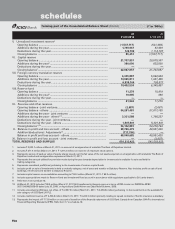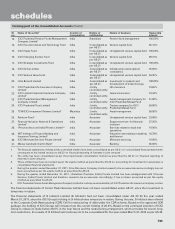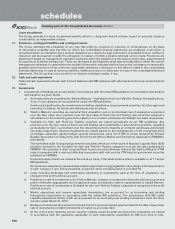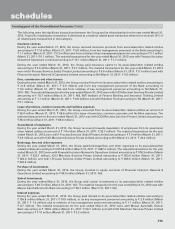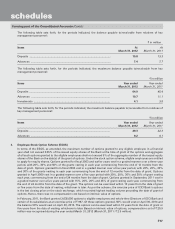ICICI Bank 2012 Annual Report Download - page 146
Download and view the complete annual report
Please find page 146 of the 2012 ICICI Bank annual report below. You can navigate through the pages in the report by either clicking on the pages listed below, or by using the keyword search tool below to find specific information within the annual report.
F68
Deferred tax assets are recognised and re-assessed at each reporting date, based on the management’s judgement as
to whether their realisation is considered as reasonably certain. However, where there is unabsorbed depreciation or
carried forward loss under taxation laws, deferred tax assets are recognised only if there is virtual certainty of realisation
of such assets.
In the consolidated financial statements, deferred tax assets and liabilities are computed at an individual entity level and
aggregated for consolidated reporting.
5. Claims and benefits paid
In the case of general insurance business, claims incurred comprise claims paid, estimated liability for outstanding
claims made following a loss occurrence reported and estimated liability for claims incurred but not reported (IBNR) and
claims incurred but not enough reported (IBNER). Further, claims incurred also include specific claim settlement costs
such as survey/legal fees and other directly attributable costs. Claims (net of amounts receivable from re-insurers/co-
insurers) are recognised on the date of intimation based on estimates from surveyors/insured in the respective revenue
account. Estimated liability for outstanding claims at the balance sheet date is recorded net of claims recoverable
from/payable to co-insurers/re-insurers and salvage to the extent there is certainty of realisation. Estimated liability for
outstanding claim is determined by the entity on the basis of ultimate amounts likely to be paid on each claim based on
the past experience. These estimates are progressively revalidated on availability of further information. Claims IBNR
represent that amount of claims that may have been incurred during the accounting period but have not been reported
or claimed. The claims IBNR provision also includes provision, if any, required for claims IBNER. Estimated liability for
claims IBNR/claims IBNER is based on an actuarial estimate duly certified by the appointed actuary of the entity.
In the case of life insurance business, claims other than maturity claims are accounted for on receipt of intimation.
Survival benefit and maturity claims are accounted when due. Withdrawals and surrenders under linked policies are
accounted in the respective schemes when the associated units are cancelled/redeemed. Re-insurance recoveries on
claims are accounted for, in the same period as the related claims.
6. Liability for life policies in force
In the case of life insurance business, liability for life policies in force and also policies in respect of which premium has
been discontinued but a liability exists, is determined by the appointed actuary as per the gross premium method in
accordance with accepted actuarial practice, requirements of the IRDA and the Actuarial Society of India.
7. Reserve for unexpired risk
Reserve for unexpired risk is recognised net of re-insurance ceded and represents premium written that is attributable
and to be allocated to succeeding accounting periods for risks to be borne by the entity under contractual obligations
on contract period basis or risk period basis, whichever is appropriate. It is calculated on a daily pro-rata basis subject to
a minimum of 50.00% of the aggregated premium, written on policies during the twelve months preceding the balance
sheet date for fire, marine, cargo and miscellaneous business and 100.00% for marine hull business, on all unexpired
policies at balance sheet date, in accordance with the provisions of the Insurance Act, 1938.
8. Actuarial method and valuation
In the case of life insurance business, the actuarial liability on both participating and non-participating policies is calculated using
the gross premium method, using assumptions for interest, mortality, expense and inflation, and in the case of participating
policies, future bonuses together with allowance for taxation and allocation of profits to shareholders. These assumptions are
determined as prudent estimates at the date of valuation with allowances for adverse deviations. No allowance is made for
expected lapses.
The greater of liability calculated using discounted cash flows and unearned premium reserves are held for the unexpired
portion of the risk for the general fund liabilities of linked business and attached riders. An unearned premium reserve
is held for one year renewable group term insurance.
The unit liability in respect of linked business has been taken as the value of the units standing to the credit of policyholders,
using the Net Asset Value (NAV) prevailing at the valuation date. The adequacy of charges under unit linked policies to
meet future expenses has been tested and provision made as appropriate. Provision has also been made for the cost
of guarantee under unit linked products that carry a guarantee. The units held in respect of lapsed policies are divided
into a revival reserve, which contributes to liabilities, and a fund for future appropriation, which contributes to regulatory
capital.
The interest rates used for valuing the liabilities are in the range of 4.93% to 6.02% per annum (previous year – 6.16%
to 6.86% per annum).
Mortality rates used are based on the published IALM (94 – 96) Ultimate Mortality Table for assurances and LIC 96-98
table for annuities, adjusted to reflect expected experience while morbidity rates used are based on CIBT 93 table,
adjusted for expected experience, or on risk rates supplied by reinsurers.
Expenses are provided for at current levels, in respect of renewal expenses, with no allowance for future improvements.
Per policy renewal expenses for regular premium policies are assumed to inflate at 5.20% (previous year – 5.90%).
forming part of the Consolidated Accounts (Contd.)
schedules


